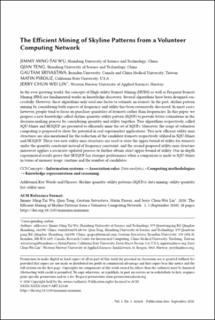| dc.contributor.author | Wu, Jimmy Ming-Tai | |
| dc.contributor.author | Teng, Qian | |
| dc.contributor.author | Srivastava, Gautam | |
| dc.contributor.author | Pirouz, Matin | |
| dc.contributor.author | Lin, Jerry Chun-Wei | |
| dc.date.accessioned | 2022-04-11T09:25:58Z | |
| dc.date.available | 2022-04-11T09:25:58Z | |
| dc.date.created | 2021-12-24T22:36:15Z | |
| dc.date.issued | 2021 | |
| dc.identifier.citation | Wu, J. M.-T., Teng, Q., Srivastava, G., Pirouz, M., & Lin, J. C.-W. (2021). The efficient mining of skyline patterns from a volunteer computing network. ACM Transactions on Internet Technology, 21(4), 1–20. | en_US |
| dc.identifier.issn | 1533-5399 | |
| dc.identifier.uri | https://hdl.handle.net/11250/2990887 | |
| dc.description | This is the author's version of the work. It is posted here for your personal use. Not for redistribution. The definitive Version of Record was published in ACM Transactions on Internet Technology, Volume 21, Issue 4, https://doi.org/10.1145/3423557. | en_US |
| dc.description.abstract | In the ever-growing world, the concepts of High-utility Itemset Mining (HUIM) as well as Frequent Itemset Mining (FIM) are fundamental works in knowledge discovery. Several algorithms have been designed successfully. However, these algorithms only used one factor to estimate an itemset. In the past, skyline pattern mining by considering both aspects of frequency and utility has been extensively discussed. In most cases, however, people tend to focus on purchase quantities of itemsets rather than frequencies. In this article, we propose a new knowledge called skyline quantity-utility pattern (SQUP) to provide better estimations in the decision-making process by considering quantity and utility together. Two algorithms, respectively, called SQU-Miner and SKYQUP are presented to efficiently mine the set of SQUPs. Moreover, the usage of volunteer computing is proposed to show the potential in real supermarket applications. Two new efficient utility-max structures are also mentioned for the reduction of the candidate itemsets, respectively, utilized in SQU-Miner and SKYQUP. These two new utility-max structures are used to store the upper-bound of utility for itemsets under the quantity constraint instead of frequency constraint, and the second proposed utility-max structure moreover applies a recursive updated process to further obtain strict upper-bound of utility. Our in-depth experimental results prove that SKYQUP has stronger performance when a comparison is made to SQU-Miner in terms of memory usage, runtime, and the number of candidates. | en_US |
| dc.language.iso | eng | en_US |
| dc.publisher | Association for Computing Machinery | en_US |
| dc.title | The Efficient Mining of Skyline Patterns from a Volunteer Computing Network | en_US |
| dc.type | Peer reviewed | en_US |
| dc.type | Journal article | en_US |
| dc.description.version | acceptedVersion | en_US |
| dc.rights.holder | © 2021 ACM | en_US |
| dc.subject.nsi | VDP::Matematikk og Naturvitenskap: 400::Informasjons- og kommunikasjonsvitenskap: 420 | en_US |
| dc.source.volume | 21 | en_US |
| dc.source.journal | ACM Transactions on Internet Technology | en_US |
| dc.source.issue | 4 | en_US |
| dc.identifier.doi | 10.1145/3423557 | |
| dc.identifier.cristin | 1971956 | |
| cristin.ispublished | true | |
| cristin.fulltext | preprint | |
| cristin.qualitycode | 2 | |
